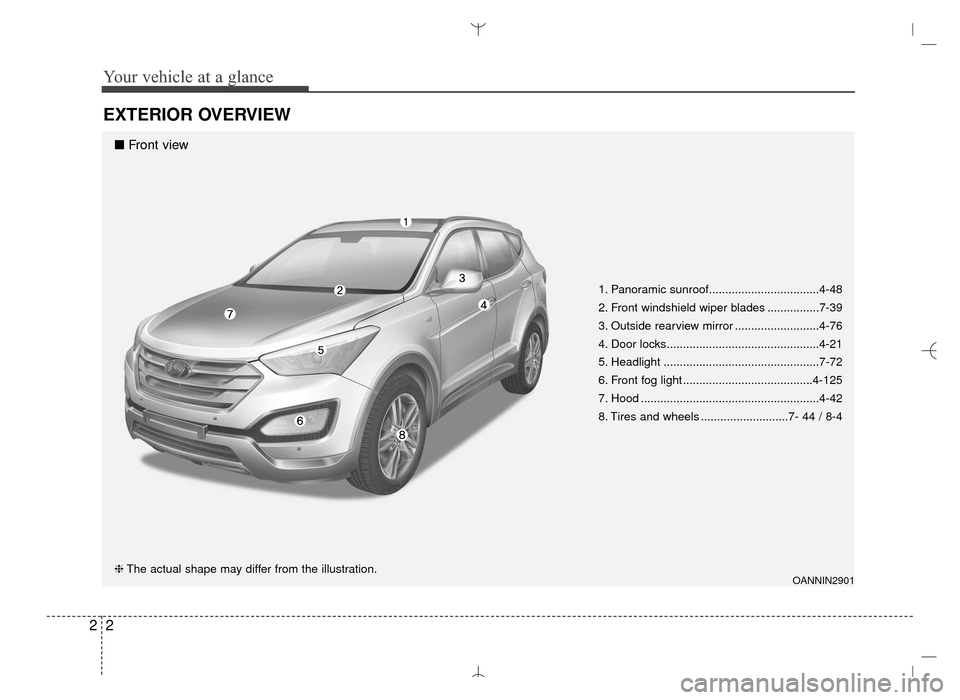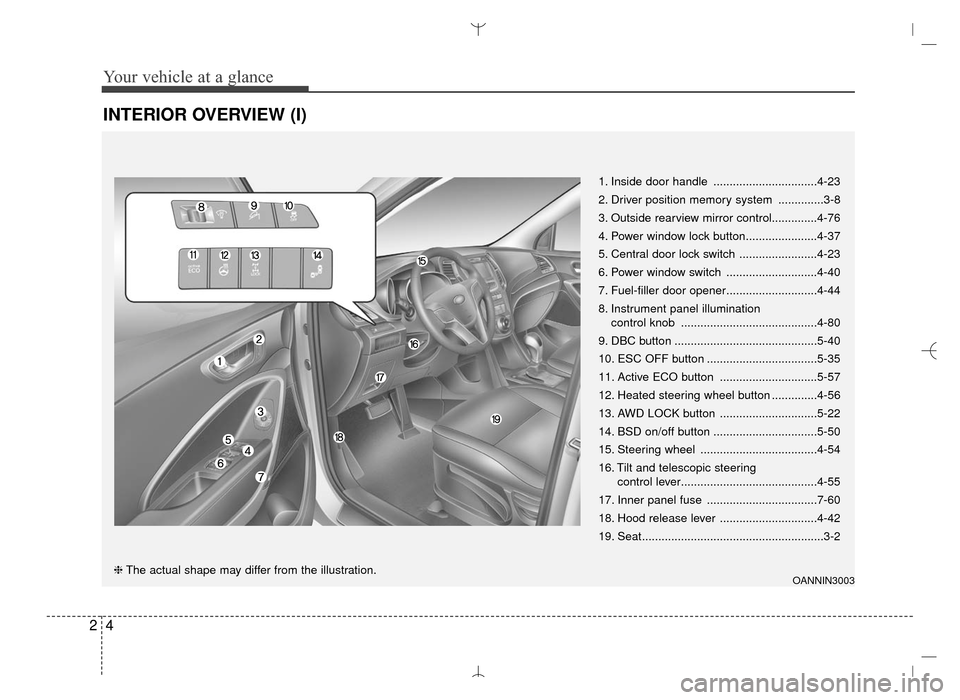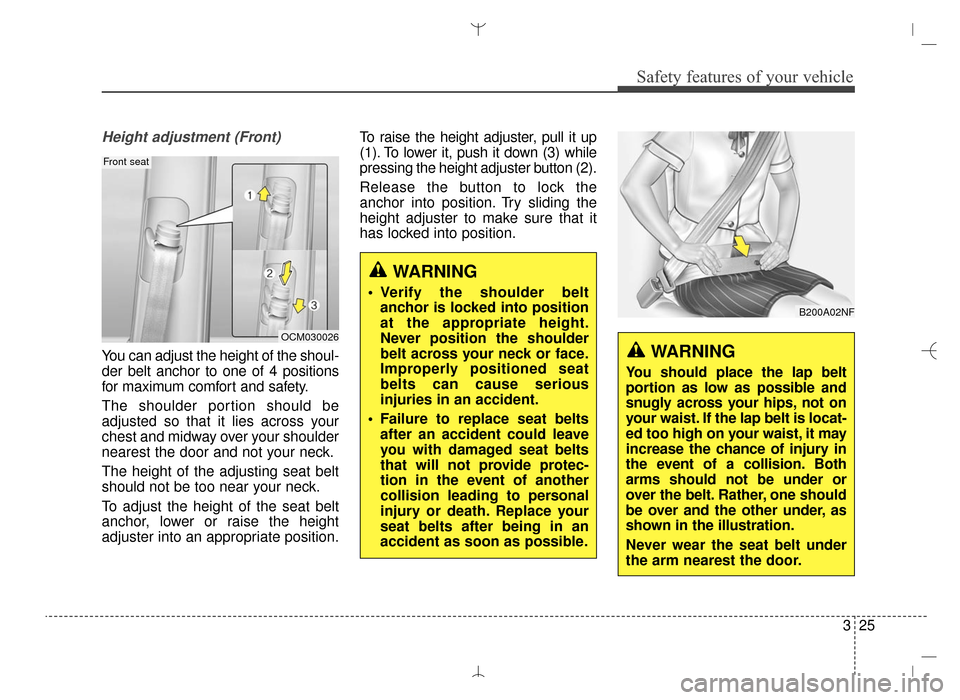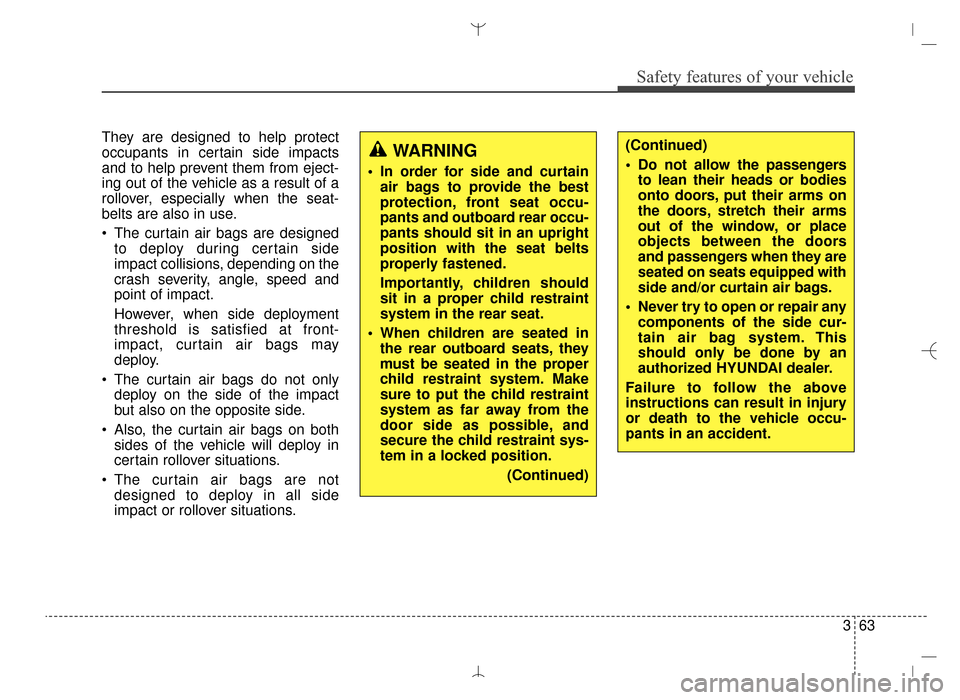2016 Hyundai Santa Fe Sport door lock
[x] Cancel search: door lockPage 7 of 763

1
2
3
4
5
6
7
8I
IntroductionHow to use this manual / Fuel requirements / Vehicle break-in process / Vehicle handling instructions /Vehicle data collection and event data recorders
Your vehicle at a glance
Exterior overview / Interior overview / Instrument panel overview / Engi\
ne compartment
Safety features of your vehicle
Seats / Seat belts / Child restraint system / Air bag
Features of your vehicleKeys / Door locks / Liftgate (Tailgate) / Windows / Hood / Fuel filler lid / Panoramic sunroof / Steering wheel /
Mirrors / Instrument cluster / Lighting / Wipers & Washers / Climate control system / Multimedia system / Etc.
Driving your vehicleBefore driving / Engine start/stop button / Transaxle / All Wheel Drive (AWD) / Brake system /
Cruise control system / Active ECO system / Winter driving / Vehicle load limit / Etc.
What to do in an emergencyRoad warning / Emergency while driving / Emergency starting / Engine overheat / TPMS / Flat tire / Towing / Etc.
MaintenanceEngine compartment / Maintenance service / Engine oil / Engine coolant /\
Brake fluid / Washer fluid /
Parking brake / Air cleaner / Wiper blades / Battery / Tire and wheels / Fuses / Light bulbs / Etc.
Specifications, Consumer information and Reporting safety defects
Index
table of contents
AN HMA FOREWORD.QXP 2015-05-07 ¿ ¨˜ 4:12 Page 7
Page 15 of 763

Your vehicle at a glance
22
EXTERIOR OVERVIEW
1. Panoramic sunroof..................................4-48
2. Front windshield wiper blades ................7-39
3. Outside rearview mirror ..........................4-76
4. Door locks...............................................4-21
5. Headlight ................................................7-72
6. Front fog light ........................................4-125
7. Hood .......................................................4-42
8. Tires and wheels ...........................7- 44 / 8-4
OANNIN2901❈The actual shape may differ from the illustration.
■ Front view
AN HMA 2.QXP 6/10/2015 11:21 AM Page 2
Page 17 of 763

Your vehicle at a glance
42
INTERIOR OVERVIEW (I)
1. Inside door handle ................................4-23
2. Driver position memory system ..............3-8
3. Outside rearview mirror control..............4-76
4. Power window lock button......................4-37
5. Central door lock switch ........................4-23
6. Power window switch ............................4-40
7. Fuel-filler door opener............................4-44
8. Instrument panel illumination control knob ..........................................4-80
9. DBC button ............................................5-40
10. ESC OFF button ..................................5-35
11. Active ECO button ..............................5-57
12. Heated steering wheel button ..............4-56
13. AWD LOCK button ..............................5-22
14. BSD on/off button ................................5-50
15. Steering wheel ....................................4-54
16. Tilt and telescopic steering control lever..........................................4-55
17. Inner panel fuse ..................................7-60
18. Hood release lever ..............................4-42
19. Seat........................................................3-2
OANNIN3003❈ The actual shape may differ from the illustration.
AN HMA 2.QXP 6/10/2015 11:21 AM Page 4
Page 46 of 763

325
Safety features of your vehicle
Height adjustment (Front)
You can adjust the height of the shoul-
der belt anchor to one of 4 positions
for maximum comfort and safety.
The shoulder portion should be
adjusted so that it lies across your
chest and midway over your shoulder
nearest the door and not your neck.
The height of the adjusting seat belt
should not be too near your neck.
To adjust the height of the seat belt
anchor, lower or raise the height
adjuster into an appropriate position.To raise the height adjuster, pull it up
(1). To lower it, push it down (3) while
pressing the height adjuster button (2).
Release the button to lock the
anchor into position. Try sliding the
height adjuster to make sure that it
has locked into position.
WARNING
Verify the shoulder belt
anchor is locked into position
at the appropriate height.
Never position the shoulder
belt across your neck or face.
Improperly positioned seat
belts can cause serious
injuries in an accident.
Failure to replace seat belts after an accident could leave
you with damaged seat belts
that will not provide protec-
tion in the event of another
collision leading to personal
injury or death. Replace your
seat belts after being in an
accident as soon as possible.
OCM030026
Front seat
B200A02NF
WARNING
You should place the lap belt
portion as low as possible and
snugly across your hips, not on
your waist. If the lap belt is locat-
ed too high on your waist, it may
increase the chance of injury in
the event of a collision. Both
arms should not be under or
over the belt. Rather, one should
be over and the other under, as
shown in the illustration.
Never wear the seat belt under
the arm nearest the door.
AN HMA 3.QXP 3/5/2015 3:09 PM Page 25
Page 84 of 763

363
Safety features of your vehicle
They are designed to help protect
occupants in certain side impacts
and to help prevent them from eject-
ing out of the vehicle as a result of a
rollover, especially when the seat-
belts are also in use.
The curtain air bags are designedto deploy during certain side
impact collisions, depending on the
crash severity, angle, speed and
point of impact.
However, when side deployment
threshold is satisfied at front-
impact, curtain air bags may
deploy.
The curtain air bags do not only deploy on the side of the impact
but also on the opposite side.
Also, the curtain air bags on both sides of the vehicle will deploy in
certain rollover situations.
The curtain air bags are not designed to deploy in all side
impact or rollover situations.(Continued)
Do not allow the passengersto lean their heads or bodies
onto doors, put their arms on
the doors, stretch their arms
out of the window, or place
objects between the doors
and passengers when they are
seated on seats equipped with
side and/or curtain air bags.
Never try to open or repair any components of the side cur-
tain air bag system. This
should only be done by an
authorized HYUNDAI dealer.
Failure to follow the above
instructions can result in injury
or death to the vehicle occu-
pants in an accident.WARNING
In order for side and curtain air bags to provide the best
protection, front seat occu-
pants and outboard rear occu-
pants should sit in an upright
position with the seat belts
properly fastened.
Importantly, children should
sit in a proper child restraint
system in the rear seat.
When children are seated in the rear outboard seats, they
must be seated in the proper
child restraint system. Make
sure to put the child restraint
system as far away from the
door side as possible, and
secure the child restraint sys-
tem in a locked position.
(Continued)
AN HMA 3.QXP 3/5/2015 3:10 PM Page 63
Page 93 of 763

Features of your vehicle
Folding key . . . . . . . . . . . . . . . . . . . . . . . . . . . . . . . . 4-4
• Record your key number . . . . . . . . . . . . . . . . . . . . . . . 4-4
• Key operations . . . . . . . . . . . . . . . . . . . . . . . . . . . . . . . . 4-4
• Precautions . . . . . . . . . . . . . . . . . . . . . . . . . . . . . . . . . . . 4-\
6
• Battery replacement . . . . . . . . . . . . . . . . . . . . . . . . . . . 4-7
• Immobilizer system . . . . . . . . . . . . . . . . . . . . . . . . . . . . 4-7
Smart key . . . . . . . . . . . . . . . . . . . . . . . . . . . . . . . . 4-10
• Record your key number . . . . . . . . . . . . . . . . . . . . . . 4-10
• Smart key function . . . . . . . . . . . . . . . . . . . . . . . . . . . 4-10
• Loss of the smart key . . . . . . . . . . . . . . . . . . . . . . . . . 4-13
• Precautions . . . . . . . . . . . . . . . . . . . . . . . . . . . . . . . . . . 4-14\
• Smart key immobilizer system . . . . . . . . . . . . . . . . . . 4-14
• Battery replacement . . . . . . . . . . . . . . . . . . . . . . . . . . 4-16
Theft-alarm system . . . . . . . . . . . . . . . . . . . . . . . . 4-17
• Armed stage . . . . . . . . . . . . . . . . . . . . . . . . . . . . . . . . . 4-17
• Theft-alarm stage . . . . . . . . . . . . . . . . . . . . . . . . . . . . 4-19
• Disarmed stage. . . . . . . . . . . . . . . . . . . . . . . . . . . . . . . 4-19
Door locks . . . . . . . . . . . . . . . . . . . . . . . . . . . . . . . . 4-21
• From outside . . . . . . . . . . . . . . . . . . . . . . . . . . . . . . . . 4-21
• From inside . . . . . . . . . . . . . . . . . . . . . . . . . . . . . . . . . 4-23
• Impact sensing door unlock system . . . . . . . . . . . . . . 4-25
• Child-protector rear door lock. . . . . . . . . . . . . . . . . . 4-25
Liftgate (Tailgate) . . . . . . . . . . . . . . . . . . . . . . . . . . 4-26
• Non - powered liftgate (tailgate) . . . . . . . . . . . . . . . . 4-26
• Power liftgate (Power tailgate) . . . . . . . . . . . . . . . . . . 4-28 • Smart liftgate (Smart tailgate) . . . . . . . . . . . . . . . . . . 4-33
• Emergency liftgate (tailgate) safety release . . . . . . . 4-36
Windows . . . . . . . . . . . . . . . . . . . . . . . . . . . . . . . . . 4-37
• Power windows . . . . . . . . . . . . . . . . . . . . . . . . . . . . . . 4-38
Hood. . . . . . . . . . . . . . . . . . . . . . . . . . . . . . . . . . . . \
. 4-42
• Opening the hood . . . . . . . . . . . . . . . . . . . . . . . . . . . . 4-42
• Closing the hood . . . . . . . . . . . . . . . . . . . . . . . . . . . . . 4-43
Fuel filler door . . . . . . . . . . . . . . . . . . . . . . . . . . . . 4-44
• Opening the fuel filler door . . . . . . . . . . . . . . . . . . . . 4-44
• Closing the fuel filler door . . . . . . . . . . . . . . . . . . . . . 4-44
• Emergency fuel filler door release . . . . . . . . . . . . . . . 4-47
Panoramic sunroof . . . . . . . . . . . . . . . . . . . . . . . . . 4-48
• Sunroof open warning. . . . . . . . . . . . . . . . . . . . . . . . . 4-49
• Sunshade . . . . . . . . . . . . . . . . . . . . . . . . . . . . . . . . . . . 4-\
50
• Sliding the sunroof . . . . . . . . . . . . . . . . . . . . . . . . . . . 4-51
• Tilting the sunroof . . . . . . . . . . . . . . . . . . . . . . . . . . . . 4-51
• Closing the sunroof . . . . . . . . . . . . . . . . . . . . . . . . . . . 4-52
• Resetting the sunroof . . . . . . . . . . . . . . . . . . . . . . . . . 4-53
Steering wheel . . . . . . . . . . . . . . . . . . . . . . . . . . . . . 4-54
• Electronic power steering . . . . . . . . . . . . . . . . . . . . . . 4-54
• Tilt & telescopic steering . . . . . . . . . . . . . . . . . . . . . . 4-55
• Heated steering wheel . . . . . . . . . . . . . . . . . . . . . . . . . 4-56
• Horn . . . . . . . . . . . . . . . . . . . . . . . . . . . . . . . . . . . . \
. . . 4-56
• Driver selectable steering mode . . . . . . . . . . . . . . . . . 4-57
4
AN HMA 4A.QXP 3/5/2015 3:17 PM Page 1
Page 96 of 763

Features of your vehicle
44
Record your key number
The key code num-
ber is stamped or
printed on the key
code tag attached to
the key set. Should
you lose your keys,
this number will enable an author-
ized HYUNDAI dealer to duplicate
the keys easily. Remove the key
code tag and store it in a safe place.
Also, record the code number and
keep it in a safe and handy place, but
not in the vehicle.
Key operations
• Used to start the engine.
Used to lock and unlock the doors.
Used to lock and unlock the glove box.
To unfold the key, press the release button then the key will unfold auto-
matically. To fold the key, fold the
key manually while pressing the
release button.
FOLDING KEY
OVF041001
CAUTION
Do not fold the key withoutpressing the release button.This may damage the key.
WARNING
Use only HYUNDAI original
parts for the ignition key in your
vehicle. If an aftermarket key is
used, the ignition switch may
not return to ON after START. If
this happens, the starter will
continue to operate causing
damage to the starter motor
and possible fire due to exces-
sive current in the wiring.
AN HMA 4A.QXP 3/5/2015 3:17 PM Page 4
Page 97 of 763

45
Features of your vehicle
Door Lock (1)
1. Close all doors, engine hood andliftgate (tailgate).
2. Press the lock button(1).
3. All doors and liftgate (tailgate) will lock. The hazard warning lights will
blink once.
4. If the lock button is pressed once more within 4 seconds, the hazard
warning lights will blink and the
horn will sound once.
5. Make sure that doors are locked by checking the door lock button inside
or pulling the outside door handle.
Door Unlock (2)
1. Press the unlock button(2).
2. The driver's door will unlock. Thehazard warning lights will blink two
times.
3. Press the unlock button(2) twice within 4 seconds and all doors and
liftgate (tailgate) will unlock. The
hazard warning lights will blink two
times.
✽ ✽NOTICE
You can activate or deactivate the
Two Turn Unlock function. Refer to
"User settings" in this section.
WARNING - Ignition key
Leaving children unattended in
a vehicle with the ignition key
is dangerous even if the key is
not in the ignition switch is in
the ACC or ON position.
Children could accidentally
place the key in the ignition
switch.
The ignition key would enable
children to operate power win-
dows or other controls, or even
make the vehicle move, which
could result in serious bodily
injury or even death. Never
leave the keys in your vehicle
with unsupervised children,
when the engine is running.
OVF041003
AN HMA 4A.QXP 3/5/2015 3:17 PM Page 5